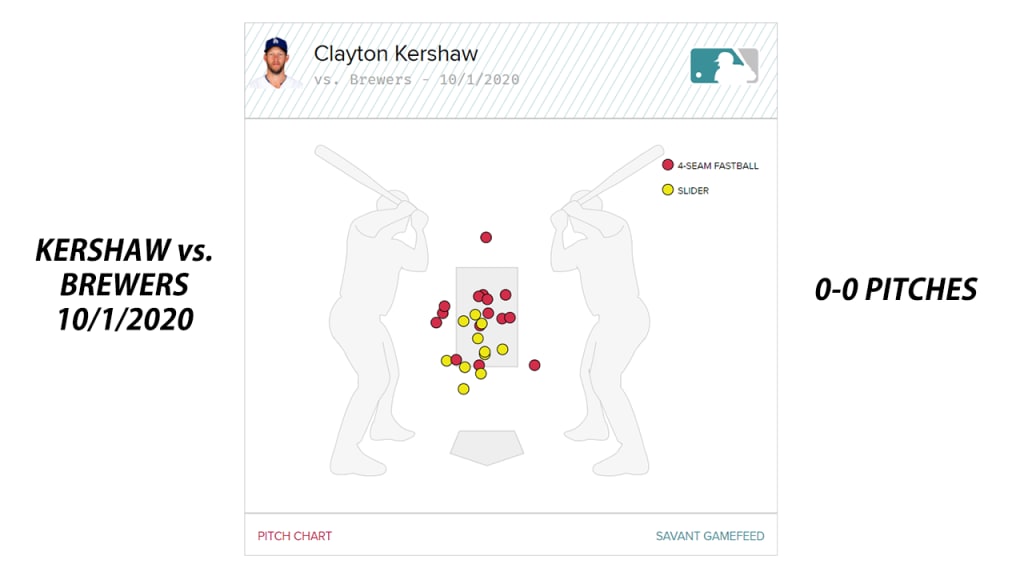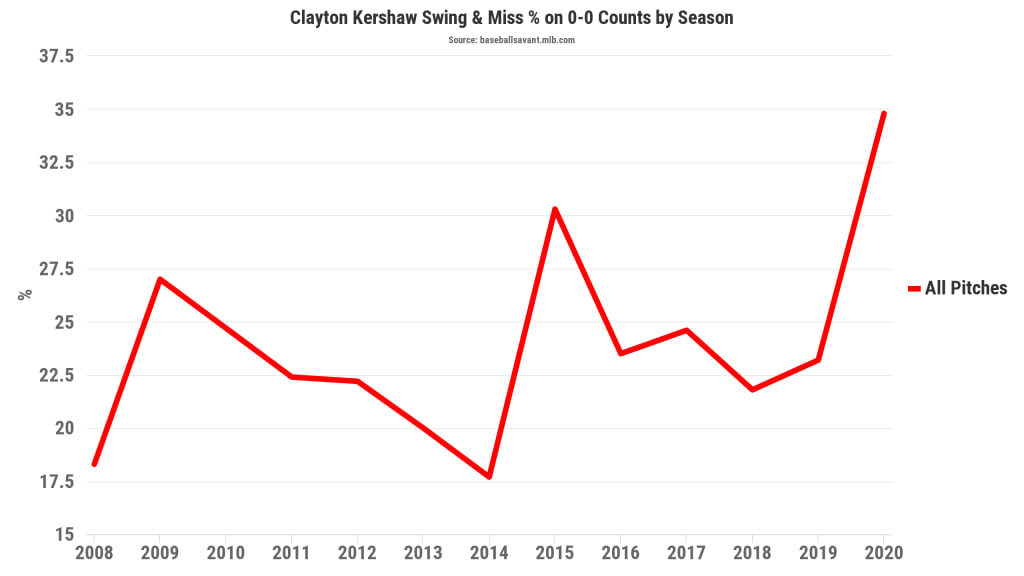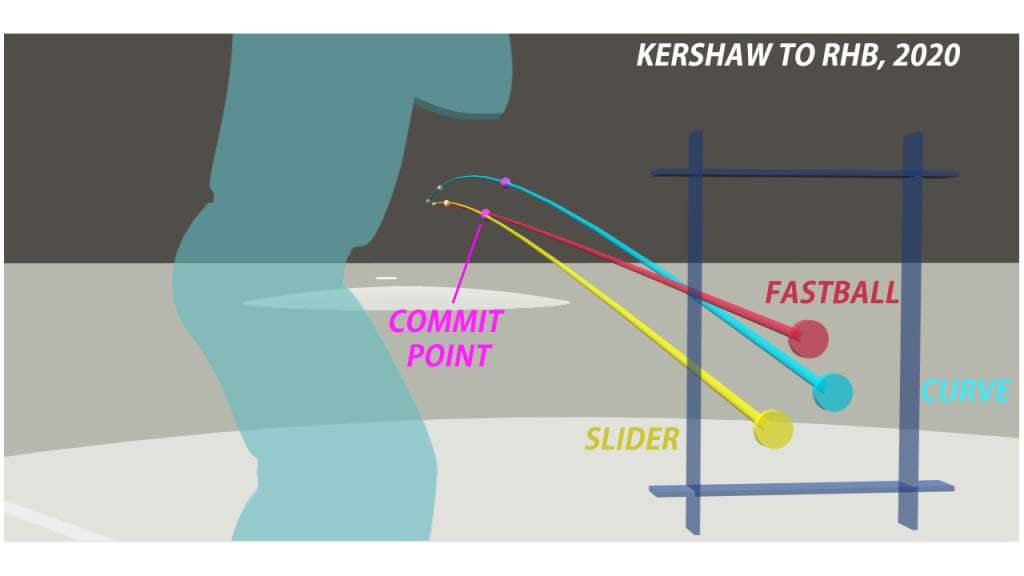Last week, in Game 2 of the Dodgers-Brewers National League Wild Card Series, Clayton Kershaw put up one of his best postseason performances -- one of the best, really, in Dodgers history. Kershaw carved up the Brewers offense, striking out 13 over eight scoreless innings while walking only one and allowing three hits.
On Wednesday night, in Game 2 of the NL Division Series, Kershaw is going to have a much tougher assignment as the Dodgers look to take a 2-0 lead in the series. The Milwaukee offense was relatively weak, the sixth weakest in baseball. Meanwhile, the San Diego offense is one of baseball's best, and is by far the strongest lineup in Padres history.
So: How does a very good offense approach one of the best pitchers to ever live, and vice-versa? Here's a hint: Keep an eye out for the first pitch.
Against Milwaukee, Kershaw faced 27 hitters, and look at what they saw on the first pitch: Four-seamers and sliders. That's it. For as many great things as you can say about Kershaw, "unpredictable" isn't one. He threw 16 fastballs and 11 sliders, and nearly all of them were in or around the zone. Only three were taken for balls.

Now, Kershaw really only throws three pitches to begin with, using his four-seam fastball and slider about 40% of the time each, with his curveball making up the remaining 20%. But on the first pitch, the curveball goes away. (He threw only four first-pitch curveballs all season long.) So on that first pitch, you have a really good idea of what you're getting -- it's fastball or it's slider, and it's probably going to be in the zone.
In fact, it's almost certainly going to be near the zone, more so than nearly anyone else, no matter which way you choose to define that. We'll take the 133 starting pitchers who faced at least 150 hitters this year, and look what we find:
• Kershaw got called strikes or swings on 70% of his first pitches, most of the 133
• Kershaw threw 79% of his first pitches into the zone or on the edges, seventh most of the 133
Guess where that leads: Lots and lots of pitches ahead in the count. The most, actually. Let's now look at the 186 starters who threw at least 200 total pitches to see who threw the fewest pitches while behind in the count, and ...
• Kershaw threw just under 20% of his pitches while behind in the count, fewest of the 186
... right.
It's a key to his success; Kershaw allowed a .216 slugging when he was ahead, and .512 slugging when he was behind.
Hitters, for the most part, have caught onto this. Kershaw has slowly been hit harder on the first pitch as the years have gone on, and this year, opposing batters had a .421 average and .737 slugging (or, for the more analytically-inclined, a .490 wOBA) when contact was made on the first pitch. "When contact was made" is doing a lot of work there, because he also had a career-high 35% swing-and-miss rate on the first pitch this year, but like many pitchers, Kershaw gives up the loudest contact on 0-0 counts. That .421 average was his highest of any count this year, and so was the .737 slugging.

We're not breaking news here. Teams know this. But despite that knowledge, against Milwaukee, the Brewers couldn't do anything at all with this. Of those 27 Brewers batters he faced, here's how those first pitches went:
• 3 hit into play (one for a single)
• 3 takes on pitches outside the zone
• 21 (!) of them fell behind 0-1, either on called strikes (10 times) or whiffs/fouls (11 times)
What does that kind of success look like? Lucky for you, we've strung all 27 of those pitches together.
So why is that so difficult? Why, when you know you have basically a coin flip's chance of knowing which pitch is coming -- and that at 91.6 mph (fastball) and 87.6 mph (slider), there's not that much of a velocity difference -- was it so hard for the Brewers to make more of an impact on the first pitch? It's partially due to the fact that the Milwaukee offense wasn't very good, sure, but it's also about the fact that Kershaw is very good at tunneling them.
That is, the fastball and the slider look the same until it's too late. See that pink area marked "commit point?" That's the point about one-sixth of a second before the plate where it's too late for the batter to make much of an adjustment, and you can see that right after is when the fastball and slider diverge. (You can see what that looks like in practice here.) In recent years, Kershaw had been at or near the top of metrics that attempted to quantify that skill.

So that, plus an unexpected late-career increase in velocity -- after a steady decline, he bumped that heater up from 90.3 mph to 91.6 mph this year -- helps explain part of why Kershaw, in his 13th year in the bigs, just posted a 2.16 ERA and is likely to get some down-ballot NL Cy Young support. What are the Padres going to do about it?
Again, we can't repeat this enough: The Padres (.798 OPS, fourth in baseball) are a much stronger offense than the Brewers (.702, 24th). They'll give Kershaw a harder time simply because they're better.
But they might be better prepared for what Kershaw does, too. The Padres had the fourth-lowest chase rate (swings outside the zone) in baseball, behind three playoff teams in the Yankees, Dodgers and A's. (They had the biggest year-to-year improvement in that area of any team.) They had the third-lowest first-pitch chase rate in baseball. And when they did make contact on the first pitch, only one team in baseball did more damage.
Best production on 0-0 counts
.480 wOBA -- Braves
.472 wOBA -- Padres
.459 wOBA -- Yankees
Guess which hitter in baseball was the most productive on 0-0? You probably already know:
So can Fernando Tatis Jr. and the Padres keep that first-pitch magic going?
Back on Sept. 14, Kershaw went into the seventh against San Diego, in a game the Dodgers would end up losing, 7-2, thanks to their bullpen getting hit hard. (Kershaw struck out nine and walked no one; he'd allowed one run and left two men on base when he exited the game.)
That time around, he faced 24 hitters, and again, threw 100% fastball/slider on the first pitch. (Sixteen fastballs and eight sliders, to be exact.) Of the 24, the Padres took nine called strikes, fouled off three and put one ball in play, a Jake Cronenworth double. While the Dodgers didn't win, it wasn't because of their starter. How that battle plays out in Game 2 might just decide the game -- and the series.


